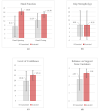A bidirectional fabric-based soft robotic glove for hand function assistance in patients with chronic stroke
- PMID: 37735679
- PMCID: PMC10512630
- DOI: 10.1186/s12984-023-01250-4
A bidirectional fabric-based soft robotic glove for hand function assistance in patients with chronic stroke
Abstract
Background: Chronic stroke patients usually experience reduced hand functions, impeding their ability to perform activities of daily living (ADLs) independently. Additionally, improvements in hand functions by physical therapy beyond six months after the initial onset of stroke are much slower than in the earlier months. As such, chronic stroke patients could benefit from an assistive device to enhance their hand functions, allowing them to perform ADLs independently daily. In recent years, soft robotics has provided a novel approach to assistive devices for motor impaired individuals, offering more compliant and lightweight alternatives to traditional robotic devices. The scope of this study is to demonstrate the viability of a fabric-based soft robotic (SR) glove with bidirectional actuators in assisting chronic stroke study participants with hand impairments in performing ADLs.
Methods: Force and torque measurement tests were conducted to characterize the SR Glove, and hand functional tasks were given to eight chronic stroke patients to assess the efficacy of the SR Glove as an assistive device. The tasks involved object manipulation tasks that simulate ADLs, and the series of tasks was done by the participants once without assistance for baseline data, and once while using the SR Glove. A usability questionnaire was also given to each participant after the tasks were done to gain insight into how the SR Glove impacts their confidence and reliance on support while performing ADLs.
Results: The SR Glove improved the participants' manipulation of objects in ADL tasks. The difference in mean scores between the unassisted and assisted conditions was significant across all participants. Additionally, the usability questionnaire showed the participants felt more confident and less reliant on support while using the SR Glove to perform ADLs than without the SR Glove.
Conclusions: The results from this study demonstrated that the SR Glove is a viable option to assist hand function in chronic stroke patients who suffer from hand motor impairments.
Keywords: Activities of daily living; Assistive device; Case Series; Chronic stroke; Fabric-based actuator; Soft robotics.
© 2023. BioMed Central Ltd., part of Springer Nature.
Conflict of interest statement
The authors declare no competing interests.
Figures










Similar articles
-
Assisting hand function after spinal cord injury with a fabric-based soft robotic glove.J Neuroeng Rehabil. 2018 Jun 28;15(1):59. doi: 10.1186/s12984-018-0391-x. J Neuroeng Rehabil. 2018. PMID: 29954401 Free PMC article. Clinical Trial.
-
Design and Preliminary Feasibility Study of a Soft Robotic Glove for Hand Function Assistance in Stroke Survivors.Front Neurosci. 2017 Oct 9;11:547. doi: 10.3389/fnins.2017.00547. eCollection 2017. Front Neurosci. 2017. PMID: 29062267 Free PMC article.
-
A Powerful Customized Fabric-Based Soft Robotic Glove for Assistance and Rehabilitation.IEEE Int Conf Rehabil Robot. 2025 May;2025:669-674. doi: 10.1109/ICORR66766.2025.11063169. IEEE Int Conf Rehabil Robot. 2025. PMID: 40643991
-
Robotic assistive and rehabilitation devices leading to motor recovery in upper limb: a systematic review.Disabil Rehabil Assist Technol. 2023 Jul;18(5):658-672. doi: 10.1080/17483107.2021.1906960. Epub 2021 Apr 16. Disabil Rehabil Assist Technol. 2023. PMID: 33861684
-
Soft robotics and functional electrical stimulation advances for restoring hand function in people with SCI: a narrative review, clinical guidelines and future directions.J Neuroeng Rehabil. 2022 Jun 30;19(1):66. doi: 10.1186/s12984-022-01043-1. J Neuroeng Rehabil. 2022. PMID: 35773733 Free PMC article. Review.
Cited by
-
Combining soft robotics and telerehabilitation for improving motor function after stroke.Wearable Technol. 2024 Jan 26;5:e1. doi: 10.1017/wtc.2023.26. eCollection 2024. Wearable Technol. 2024. PMID: 38510985 Free PMC article.
-
A magnetically controlled soft robotic glove for hand rehabilitation.Device. 2024 Sep 20;2(9):100512. doi: 10.1016/j.device.2024.100512. Epub 2024 Aug 22. Device. 2024. PMID: 40018444
-
Development and Evaluation of a Novel Upper-Limb Rehabilitation Device Integrating Piano Playing for Enhanced Motor Recovery.Biomimetics (Basel). 2025 Mar 25;10(4):200. doi: 10.3390/biomimetics10040200. Biomimetics (Basel). 2025. PMID: 40277599 Free PMC article.
References
-
- Brain’s Diseases of the Nervous System. Donaghy M, editor: Oxford University Press; 2009 01 Jul 2011.
-
- Kwakkel G, Kollen BJ, van der Grond J, Prevo AJ. Probability of regaining dexterity in the flaccid upper limb: impact of severity of paresis and time since onset in acute stroke. Stroke. 2003;34(9):2181–6. doi: 10.1161/01.STR.0000087172.16305.CD. - DOI - PubMed
Publication types
MeSH terms
LinkOut - more resources
Full Text Sources
Medical
Research Materials

